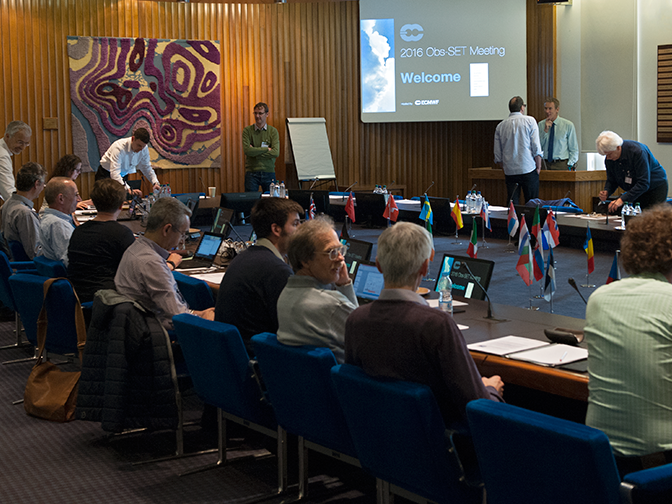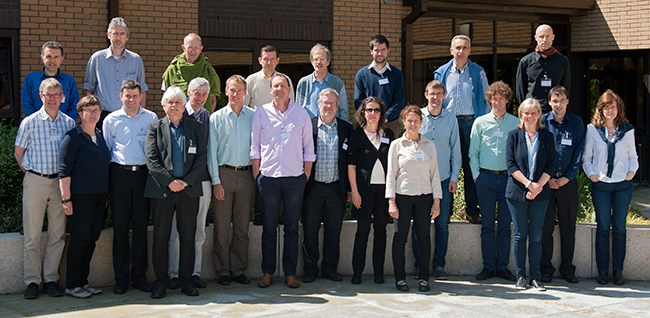

About 30 scientists from 10 European countries met at ECMWF from 23 to 25 May 2016 to explore how European non-satellite meteorological observing systems can be optimised.
The meeting of the EUMETNET Observations Scientific Expert Team (Obs-SET) focussed on ‘ground-based’ observations, which include aircraft data, weather radar and marine observations.
The team provides advice on the observation programmes coordinated by EUMETNET, a network of 31 weather services. Together, they manage some of the most vital observation assets for numerical weather prediction in Europe.
Their networks collect observations from ships and buoys in the Atlantic and from European aircraft as well as the traditional land-based stations. Investments in new technology and trials are also managed jointly or coordinated.
Obs-SET’s role is to review the progress of the observation programmes annually and to provide advice on the impact and value of various components of the networks to decision makers.
Aircraft data
The WMO’s AMDAR programme provides aircraft observations of humidity, temperature and wind. Following ECMWF and German Weather Service (DWD) evaluations in 2015, various forecasting centres have begun or are planning to assimilate AMDAR humidity data operationally to help initialise forecasts.
Meteorological data (primarily wind data) is being extracted from air traffic control (MODE-S) messages in northern and central Europe. The huge volumes of reports generated are being evaluated.
The meeting discussed future requirements for turbulence and icing data from aircraft.

About 30 people from 10 European countries took part in the EUMETNET Observations Scientific Expert Team (Obs-SET) meeting.
Weather radars
Weather radars provide precipitation estimates, and often radial winds whilst precipitation is occurring. These are important for numerical weather prediction, especially for short-term high-resolution forecasts.
The data are exchanged via the Operational Programme for the Exchange of Weather Radar Information (OPERA), whose goal it is to provide a coherent European coverage of radar data, with uniform quality control. Both 2D precipitation fields and, increasingly, 3D reflectivity scans are available.
Special, near-vertical radars produce frequent wind profiles above the ‘profiler’ stations. Vertically pointing lasers provide cloud and aerosol information.
The data from ground-based GNSS receivers are processed to provide estimates of the vertically integrated humidity above the stations. Some numerical weather prediction centres are assimilating these observations, whilst others are evaluating them.
Marine observations
EUMETNET coordinates a project that mounts radiosonde units on about 20 commercial ships plying different routes in the North Atlantic. The reports are valuable for weather prediction. The quality of the different systems in use was discussed.
Buoys and ships provide measurements of surface meteorological fields and also sea-surface temperature. Drifting buoys in particular help to fill gaps in what would otherwise be data-void areas.
In recent years, E-SURFMAR drifting buoys have been deployed north of Iceland to fill an important gap there. ECMWF and Météo-France presented preliminary reports aimed at informing future deployment strategy.
Surface and radiosonde reports are the subject of a WMO-led migration from alphanumeric to binary codes (BUFR). For radiosondes in particular there is provision for reporting extra data, but this comes with added complexity and a change to report structure that is slowing the migration.
Many European countries are providing and using good BUFR data, but there are still some aspects that need to change. Regular observation monitoring is also necessary to spot problems and ensure that required data are available.
Developments in use of observations
There were presentations on recent developments in the numerical weather prediction systems of the UK, Germany, France, Italy and Hungary. Several of these countries have made significant upgrades in resolution and observation data usage over the last 12 months.
'Crowd-sourced' observations, such as from the UK Met Office’s Weather Observations Website, were also discussed. They present an opportunity but also practical challenges, primarily to do with consistency and quality. For now, many countries are exploiting other sources, such as roadside weather networks.
The benefits of a prompt exchange of observation data between European countries is very apparent, but such an exchange also brings challenges. The collaboration via EUMETNET plays an important role in encouraging and enabling such a data exchange to the benefit of all European weather services.
